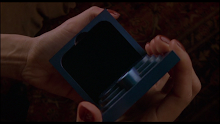2001, a movie about outer space, obeys Newtown's law of gravitation.
What goes up into space must always com down, and so carried away spectator must also come back down to Earth and fall on his feet.
The link shot between the bone and the spaceship which created the surprising narrative ellipsis has often been discussed.
I see in this montage the line of a double parable : the parable of the evolution of mankind, and a mathematical parabola represented by the movie's images.
Demonstration
(Readers be pleased to go to the french version to see images)
After the monolith episode, the hominids live in the darkness of the moment. Before an animal carcass, one of them becomes seemingly perplex.
The memory of the mysterious monolith comes to his mind.
The monolith, designed and created by an intelligent force (divine or alien ?), represents the driving force of evolution.
The ape comes up with the first idea : tools.
A tool which turns out to be...a weapon (Notice the striking short cut by Clarke/Kubrick : the story of humanity is a story of destruction, destruction that will always lead man in this inevitable evolution towards...?)
The killing of the animal is a splendid scene. It represents at the same time, the logical link between the carcass and the killing and the hominid's mental image with the new tool which he uses to kill the animal.
This represents the beginning of a new era : the image of the animal is no loger part of instict's eternal present, but lives in the mental timeframe of memory and desire.
This is th birth of humanity.
Armed with its newly found power, animal becomes man defying the heavens with his actions.
The bone begins to fall, obeying gravity. But the bone does not land.
This act is the act of humanity.
Millions of years later, a spaceship makes its a through outer space.
Notice the movement of the spaceship towards the left side of the frame.
We can consider that the sequence ends here : man has conquered space.
But it's not over. The parable/parabola continues... formal...visual.
We can easily relate the pen found in the spaceship to that first tool-weapon thrown in the dawn of humanity.
A rocket-pen suspended in the air that hasn't landed on the ground yet.
The parabola drawn by the movement of these objects throughout the film continues to grow until the final scene...and that enigmatic shot...the glass falls and the pieces of glass scatter all over, like the bones of the animal's skeleton.
The astronaut stops the fall. he becomes perplex, pensive.
The line of the parabola is drawn : the path of the bone thrown into the air at the beginning of the film reaches its end in this mysterious paradoxical antechamber of the universe.
A truth, just like the first idea appeared to th first man, appeared in the mind ot the man ho had travelled through space.
He faces the parabola/parable constructed throughout the film : man himself, in the ultimate instant, faced with the origin of his origin.




















